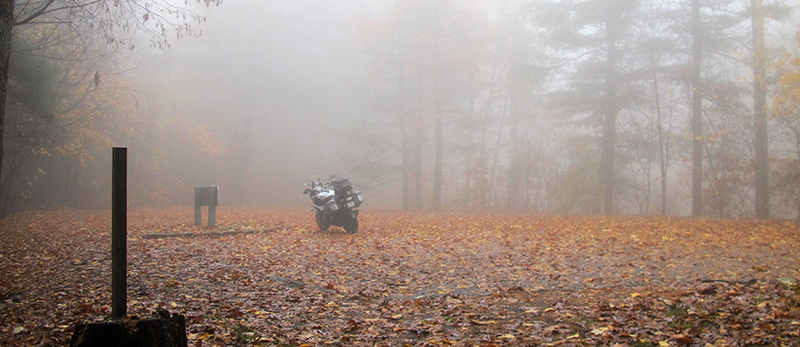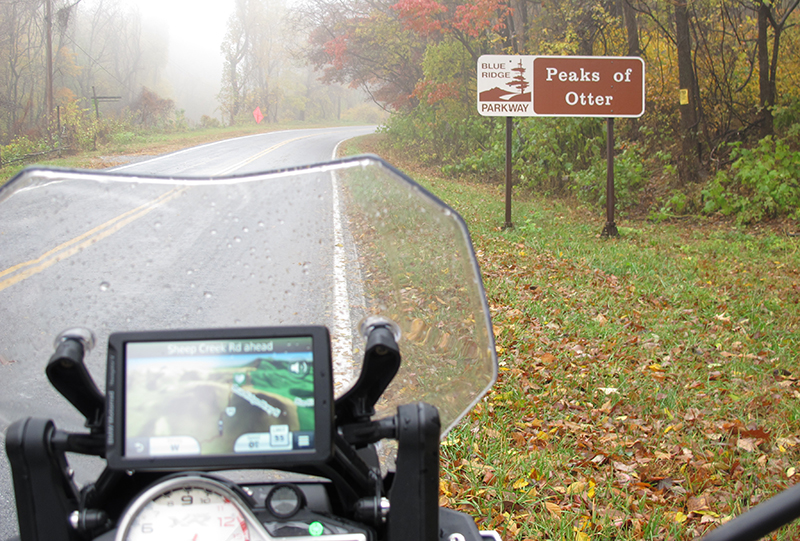Editor's note: Originally published in January, 2010, the tips and techniques for riding in the rain writer George Tranos outines here haven't changed. That said, we have refreshed this article which covers the basics that all motorcyclists need to consider when riding in the rain.
Riding in the Rain
Nothing beats motorcycle riding with the sun shining on your back. A nice warm spring day seems to bring out motorcycles and bugs in equal numbers. Unfortunately, there will be times when the skies open up and riding in the rain becomes unavoidable. Here are some strategies for riding in wet conditions.

First, don't panic! If you're caught out unaware, consider slowing down or even stopping. Some showers and thunderstorms pass quickly and by stopping you might be able to avoid the rain entirely. Check the weather forecast, be prepared for the rain with the proper clothing and motorcycle gear, and plan your trip accordingly. If you don't stop, you should be aware of the additional risks.
Slick Roads
The first few minutes of even light rain can be the most dangerous time to ride, especially if it hasn't rained in a long time. The water mixes with the oil, dirt, and road debris creating a slick surface. Motorcycle tires put down a very narrow footprint and once the pavement gets slippery, traction is limited. Try to avoid riding during this initial period.
While traction is still reduced even after the grime is washed away, newer tires properly inflated with plenty of tread can offer excellent wet weather grip. Make sure you are maintaining your motorcycle properly and don't skimp on those pre-ride checks, especially when it comes to your motorcycle tires.

Be Smooth
Wet weather rides mean being extra smooth during throttle, clutch, and brake application. Avoid sudden acceleration or braking, especially in curves where traction is already limited. Take turns more gradually with reduced lean angles and slower speeds.
Roadway features such as railroad tracks, bridge gratings, painted lines, and tar patches will be extra slippery when wet and should be crossed with the motorcycle as upright as possible (more traction). Above all, leave extra time and space so you don't have to take any sudden actions.

Hydroplaning
Motorcycles will hydroplane when water builds up and creates a layer of water between the tires and the road. Hydroplaning results in a complete loss of traction and can cause a serious crash. Normally, hydroplaning will occur when you try to ride through a deep puddle, but it could also occur during periods of heavy rain when the roadway doesn't have time to drain sufficiently. If you notice these circumstances, slow down and consider stopping if you continue to encounter possible hydroplaning conditions.

Reduced Visibility
Riding in the rain has other risks as well. Your ability to see is greatly reduced. Rain droplets will hit your windshield and/or helmet faceshield impairing your vision. If you normally ride with a tinted visor, make sure you bring a clear shield that you can use when the rain starts. You can treat your shield with an anti-fog product or install a Pinlock visor. At the minimum, your shield should be clean and have a minimum of scratches that impair visibility. Wear waterproof motorcycle gloves that have a rubber wiper so you can clear your shield quickly if needed. Do not override your visibility; leave sufficient room and be diligent about scanning aggressively to anticipate hazards.
Just as you have difficulty seeing, other drivers will have a hard time seeing you. Now is the best time to use bright and reflective material as part of your riding gear. If your riding gear is dark, consider purchasing a bright reflective vest. It can be carried with you in a tank bag or saddlebag and taken out when visibility is poor (or at night). Add reflective tape to your saddlebags, travel trunk, rear fender, or other spots to help other drivers see you. You might also consider upgrading and adding additional lighting to your motorcycle. These simple additions can make you visible from twice the distance in bad conditions.
Rider Comfort and Hypothermia
Nothing is worse than being cold. The body shuts down blood flow to the extremities first to protect the inner core functions. When body temperature is reduced even more, hypothermia can set in. When that happens, your body functions slowly deteriorate. Coordination, judgment, and reflexes diminish.
A person who has hypothermia can initially appear drunk. Their coordination is lost and words may be slurred. You don't want to be riding a motorcycle under these conditions. Being wet in addition to being cold will bring on hypothermia even faster. Proper riding gear is necessary to keep your body warm and dry, especially in early spring when the ambient outside temperature is already cold. Choose and use jackets, gloves, pants, and boots that either have waterproof, breathable liners such as Gore-Tex, or bring appropriate rain gear.

While riding in the rain may never be as pleasurable as being out on a bright, warm, sunny day, it can be tolerable if you're prepared with the right gear and attitude. If you're aware of the weather, prepared for the rain and cold, and outfit you and your motorcycle properly, then riding in the rain doesn't have to be unpleasant. Practice riding as smoothly as possible, avoid panic, and leave yourself enough space and time to avoid any sudden actions so you will be able to ride in wet weather more safely.
About the Author
George Tranos is a New York State and MSF-certified RiderCoach and a freelance writer.

Some good advice in here for sure but a bike that is properly fitted to the rider is a major factor. I also know that many people buy a bike for the name on the tank. But as with all new technology, there are options. My Motto Guzzi California has levels of traction control. I also have a program setting for rain which removes torque from the throttle. It makes for a confident, controlled ride in all conditions, even light snow. Time for people to decide if the name is worth the risk or if the ride is what they want.
For those that don’t already have foul weather gear, take the time to shop at local marine supply stores for rain suits. There’s a ton of reasonably priced gear that will keep you both dry and warm that won’t gouge your wallet because it’s “motorcycle gear.” Last year I bought (for less than $100) a two-piece, hi-viz suit with reflective strips that allows me to ride in the worse of storms for four to five hours in a hoodie and jeans perfectly comfortable.
Here is a wonderful little trick I use while riding in the desert. When it’s 100 degrees and hotter I buy a large bag of ice from the local convenience market, place it between the windshield and the triple tree and as it melts I ride in what feels like air conditioning. Try it and you’ll never ride in the desert without it again. By the way, a large bag of ice only lasts about four hours. Give it a go.
Sounds like a great idea, Joe! I would just caution readers to be sure that the bag of ice is secured so as to not interfere with the bike’s steering.
I always choose wet/dry wheels for my enduro motorcycles. Absolutely love riding in the rain and the extra confidence and stability in knowing my treads are deep enough to handle the wet makes it almost the same as riding on dry roads.Only difference is breaking distance and of course slowing down in corners. Also, I’m often the only rider around for ages but I love it because I’m an all weather type rider!
I’m at the 2015 Sturgis Rally and have been caught in the rain twice while riding. If it is possible to pull over and wait it out that’s good. If not I try and stay alert, slow down, and ride at a speed that I feel comfortable riding in. I try to watch out for me and my surroundings and go at a pace that is good for me even if I don’t ride as fast as the others in my group. I try to get there safely. That is important. Hoping for sunny skies the rest of the rally. Having a great time!
Love all the good, helpful advice. Keep doing what you’re doing.
Sturgis Biker Belle Ride 2014 — that was the most rain I have ridden in. Everything was soaked but everyone kept good spirits. One hint that I used was to hug my knees as close to the frame as possible. This causes you to “feel” your ride better. I had a new rider with me and we just slowed down, let her gain confidence and enjoyed the experience of a first.
The first two photos in this article were taken during that event so, yes, we know what you mean about the rain that day. Kudos to you and your friend for powering through it!
On a trip from Florida to Michigan, I was caught in rain three miles from my hotel. It was getting dark, raining, and I was finding my hotel, and on the interstate no less! I didn’t stop to get rain gear on because I was so close. Thankfully the traffic wasn’t heavy and drivers had slowed down, but I also liked that they seemed to give me space. I was quite proud of myself because I handled it well and made it safely to a great hotel, but I plan my hotel stops better since.
I’ve also found that keeping a rainguard spray on my visor and windscreen helps a ton. I use Raincoat Pro by MotoSolutions, but they’re not the only brand out there. Keeps my view clear and reduces the sparkly-light refraction effect from oncoming headlights. Much safer than taking a hand off the controls to wipe your visor!
I’ve been caught in the rain once. It was a light rain and I enjoyed it. Is there a glove that helps clear the water from the helmet shield?
I have a pair of gloves from Firstgear that have a rubber strip on the left thumb that works as a “windshield wiper” when it’s raining. Works somewhat. You might look into gloves from Firstgear and check for the ones that have that feature. It’s better than not having it.
Could not have been more timely! Terrific advice. Thank you.
Thanks for all the nice hints. I will be looking at rain gear more carefully now before purchasing.
Wished there had been something like this available to me the first time I got caught traveling in the rain. Would have been a much easier ride with at least some idea of what to expect.